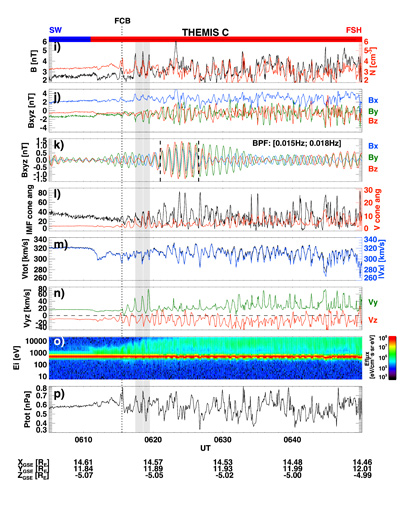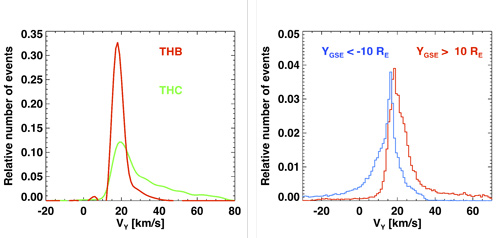
2019 THEMIS SCIENCE NUGGETS
Sheath-like solar wind deflection upstream of the bow shock
by Olga Gutynska
Faculty of Mathematics and Physics, Charles University, Czech Republic
Introduction
A foreshock is the upstream region magnetically connected to the bow shock where reflected particles interact with the upcoming solar wind. This interaction creates nonlinear waves and a lot of structures in this area depending on the upstream interplanetary magnetic field (IMF) orientation. To facilitate understanding of upstream processes, we start from presenting the results of a 2.5-D (2-D in space and 3-D in currents and electromagnetic fields) electromagnetic hybrid simulation run for foreshock activity during an interval of radial IMF. We show for the first time, that nonlinear waves and foreshock expansion in connection with the development of cavitons and formation of the foreshock compressional boundary (FCB) (e.g., Kajdic et al. [2017]), participate in the magnetosheath-like plasma flow deflection prior to the encounter with Earth's magnetosphere. Furthermore, we demonstrate that THEMIS observations of large amplitude, low frequency, quasi-periodic and quasimonochromatic plasma and magnetic field variations and asymmetric Vy fluctuations are consistent with simulation predictions and can be associated with foreshock expansion under radial IMF.
Simulations
Figure 1 presents the spatial structure of foreshock parameters at the end of the simulation run: the normalized values of X, Y components of the magnetic field (panels a, b), normalized plasma number density (panel c) and ion velocity in the Y direction (panel d). Magnetic field lines shown at the top two panels distinguish the approximate FCB location. Panels a shows the excitation of highly compressional waves that propagate at large angles with respect to the IMF that can be classified as magnetosonic waves, and panel b shows transverse fast waves that propagate at small angles with respect to the IMF. The joint nonlinear evolution of these two classes of waves results in the formation of cavitons marked in panel c (the core with a low density and rim of high density). The formation of a single caviton entails the outward expansion of the plasma and magnetic field away from the core. In panels a and c, the FCB is marked and it exhibits the largest amplitude near the shock and gets weaker with a larger distance from the shock.
Through applications of this detailed dataset to modeling, we were able to investigate why signatures identified in measured wave data were consistent with the measured composition and in the process demonstrate the value of detailed plasma composition measurements for characterizing EMIC waves. In the process we also found that the wave properties previously identified and thought to be peculiar were likely consistent with theory. Figure 2 is an excerpt of modeling performed with linear theory using the detailed plasma composition measured by MMS that shows peak wave growth rate occurring for EMIC waves parallel to the magnetic field (kperp = 0) in a wave frequency range consistent with the peak wave power identified in MMS data.
| Figure 1. Plots of compressional (a) and transverse (b) magnetic fields normalized to IMF value. Also are shown density (c) normalized to solar wind value and Vy (d) normalized to Alfven speed. For clarity in the foreshock, Vy scale is artificially set at -1 to +1. Virtual spacecraft locations: S1 (X = 843 , Y = 859) ; S2 (X = 854 , Y = 654) ; S3 (X = 1182 , Y = 890) ; S4 (X = 1202 , Y = 591). |
Observations
Figure 2 presents THEMIS C plasma and magnetic field observations in the pristine solar wind (blue horizontal bar), foreshock edge and inner foreshock (red horizontal bar) during a 45-min interval on July 7, 2008. The data show the simultaneous increase of the magnetic field magnitude and density that characterize FCB at approx. 0615 UT. The FCB is followed by two distinct cavitons (marked by vertical shaded area) with correlated depressions of the magnetic field and density bounded by significant enhancements of both these quantities. The solar wind flow starts to deflect (V cone angle fluctuation amplitude increases and coincides with IMF cone angle changes) almost simultaneously with the appearance of large fluctuations in magnetic field at both spacecraft locations. Note the asymmetric fluctuations of Vy toward more positive values together with two identified cavitons in THEMIS C observations leading to the deflection of the mean flow direction that is consistent with the model predictions.
| Figure 2. Figure 2. THEMIS C observations of: (j) magnetic field magnitude (black) and density (red); (j) GSE magnetic field components; (k) GSE magnetic field components processed by band-pass filter; (l) IMF (black) and solar wind flux (red) cone angles; (m) the solar wind total velocity (black) and Vx (blue); (n) Vy (green) and Vz (red) velocity components; (g, o) ion energy spectra from the ESA instrument; and (h, p) total pressure. The vertical shaded area marks two observed cavitons. |
To further illustrate the behavior of asymmetric fluctuations of Vy we plotted a histogram of Vy for both spacecraft in Figure 3 (left). The distributions peak at Vy +20km/s, in accord with the mean direction of the solar wind flow, but a longer tail to the right of the maximum skews both distributions. Also, we performed a small statistical study of spatial symmetry of the ion velocity Vy component. We selected observations during radial IMF periods from October 24, 2007 to January 3, 2010. Figure 3 (right) shows a histogram of the Vy component in the foreshock for the cases where the YGSE component of the spacecraft location was larger than 10 RE or less than -10 RE. These criteria divide observations into those detected at the dusk and dawn foreshocks, respectively. Figure 3 (right) clearly demonstrates that the features shown in the left panel are typical and that distributions are skewed duskward in the dusk foreshock and dawnward in the dawn foreshock.
| Figure 3. Left: Distributions of the solar wind velocity Vy component in the foreshock for THEMIS B (red) and C (green) on July 7, 2008 for 0630 - 0730 UT time interval. Right: Distributions of the solar wind velocity Vy component in the foreshock for radial IMF (cone angles < 15) for spacecraft locations with YGSE coordinates less than -10RE (blue) and larger than 10RE (red). |
Conclusion
We presented a case study of dusk foreshock observations during radial IMF. In good agreement with simulation predictions, Vy fluctuations were skewed toward the positive (duskward) values and observed simultaneously with two cavitons by the THEMIS C spacecraft. From our statistical study of foreshock velocities during a radial IMF, we can conclude that large asymmetrical Vy velocity component fluctuations are typical. The asymmetry of fluctuations changes the mean direction of the incoming solar wind flow within the foreshock leading to preconditioning prior to its encounter with the bow shock. Simulation results predicted that such phenomena can be explained by foreshock expansion that caused development of cavitons and further sheath-like solar wind deflection.
Reference
Gutynska, O., Omidi, N., Sibeck, D. G., Nemecek, Z., Safrankova, J., Lynnyk, A. (2020), Solar wind deflection in the foreshock: Model‐data comparison. Journal of Geophysical Research: Space Physics, 125, e2019JA026970. https://doi.org/10.1029/2019JA026970Kajdic, P., X. Blanco-Cano, N. Omidi, D. Rojas-Castillo, D. G. Sibeck, and L. Billingham (2017). MMS measurements and modeling of peculiar electromagnetic ion cyclotron waves. Traveling Foreshocks and Transient Foreshock Phenomena, J. Geophys. Res., 122, 9148-9168, https://doi.org/10.1002/2017JA023901.
Biographical Note
Olga Gutynska is a Researcher in the Dept. of Surface and Plasma Science, Faculty of Mathematics and Physics at Charles University. Her main scientific focus is turbulent processes in planetary sheaths. She is also interested in research of waves in the foreshock region and substorm-related processes in the magnetosphere.
 Please send comments/suggestions to
Emmanuel Masongsong / emasongsong @ igpp.ucla.edu
Please send comments/suggestions to
Emmanuel Masongsong / emasongsong @ igpp.ucla.edu



